Search
Search Results
-
Swimming Motility Assays of Spiroplasma
Spiroplasma swim in liquids without the use of the bacterial flagella. This small helical bacterium propels itself by generating kinks that travel...
-
Swarming Motility Assays in Salmonella
Salmonella enterica has six subspecies, of which the subspecies enterica is the most important for human health. The dispersal and infectivity of...
-
Methods for Studying Swimming and Surface Motilities in Rhizobia
Rhizobia are soil proteobacteria able to establish a nitrogen-fixing interaction with legumes. In this interaction, rhizobia must colonize legume...
-
Outer membrane protein of OmpF contributes to swimming motility, biofilm formation, osmotic response as well as the transcription of maltose metabolic genes in Citrobacter werkmanii
Bacterial outer membrane proteins (Omps) are essential for environmental sensing, stress responses, and substance transport. Our previous study...

-
Diversity in the swimming motility and flagellar regulon structure of uropathogenic Morganella morganii strains
In current times, the opportunistic pathogen Morganella morganii is increasingly becoming a cause of urinary tract infections. The condition has been...

-
Force Measurement of Bacterial Swimming Using Optical Tweezers
Velocity is a physical parameter most commonly used to quantify bacterial swimming. In the steady-state motion at a low Reynolds number, the swimming...
-
Methods to Analyze Motility in Eury- and Crenarchaea
Many archaea display swimming motility in liquid medium, which is empowered by the archaellum. Directional movement requires a functional archaellum...
-
Motility mediates satellite formation in confined biofilms
Bacteria have spectacular survival capabilities and can spread in many, vastly different environments. For instance, when pathogenic bacteria infect...

-
Motility of Acinetobacter baumannii: regulatory systems and controlling strategies
AbstractAcinetobacter baumannii is a Gram-negative opportunistic zoonotic pathogenic bacterium that causes nosocomial infections ranging from minor...

-
Bacterial motility: machinery and mechanisms
Bacteria have developed a large array of motility mechanisms to exploit available resources and environments. These mechanisms can be broadly...

-
Inhibition of bacterial swimming by heparin binding of flagellin FliC from Escherichia coli strain Nissle 1917
Escherichia coli Nissle1917 (EcN) is a non-pathogenic probiotic strain widely used to maintain gut health, treat gastrointestinal disorders, and...

-
Analysis of Adhesion and Surface Motility of a Spirochete Bacterium
Spirochetes are Gram-negative bacteria with helical or flat wave morphology and move using flagella residing beneath the outer membrane. Most...
-
Aqp4a and Trpv4 mediate regulatory cell volume increase for swimming maintenance of marine fish spermatozoa
Volume regulation is essential for cell homeostasis and physiological function. Amongst the sensory molecules that have been associated with volume...

-
IKBA phosphorylation governs human sperm motility through ACC-mediated fatty acid beta-oxidation
The nuclear factor-κB (NF-κB) signaling pathway regulates specific immunological responses and controls a wide range of physiological processes....

-
Effect of samarium oxide nanoparticles on virulence factors and motility of multi-drug resistant Pseudomonas aeruginosa
Biofilm formation and quorum sensing (QS) dependent virulence factors are considered the major causes of the emergence of drug resistance,...

-
Role of the sigma factor AlgU in regulating growth, virulence, motility, exopolysaccharide production, and environmental stress adaptation of Pseudomonas syringae pv. actinidiae QSY6
The extracytoplasmic function (ECF) sigma factor AlgU is involved in the regulation of various virulence-related pathways in Pseudomonas syringae ,...

-
Flagellar motility of Pseudomonas syringae pv. actinidiae biovar 3 contributes to bacterial infection through stomata
Highly virulent Pseudomonas syringae pv. actinidiae biovar 3 (Psa3) causes kiwifruit bacterial canker, which seriously damages kiwifruits worldwide....

-
Deletion of the cheZ gene results in the loss of swimming ability and the decrease of adhesion ability to Caco-2 cells in Escherichia coli Nissle 1917
The aim of this study was to elucidate the biological functions of the motility regulatory protein CheZ in the probiotic strain Escherichia coli ...

-
Morphological differences in tardigrade spermatozoa induce variation in gamete motility
BackgroundFertilization is an event at the beginning of ontogeny. Successful fertilization depends on strategies for uniting female and male gametes...

-
Motility and size of rotifers as risk factors for being consumed by the passive protistan predator Actinosphaerium sp.
Predation is a well-known factor that structures rotifer communities. However, the role of protists as predators is relatively understudied. Here, we...

